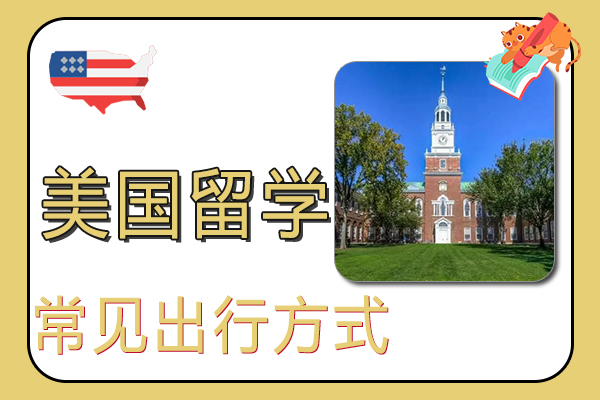During their study in the United States, students studying abroad have to travel a lot.Common travel methods for studying in the United StatesForum on Studying in the United States, ,Studying in American High School, ,Deer Hunter Case Study in the United States Living Expenses, ,Cost of living in the United StatesThe problem.

Common travel methods for students studying in the United States
1. Common travel methods for studying in the United States
1. Bicycle
Sometimes a bicycle is all you need for international students in the US. Some universities in rural areas are so large that students need to use bicycles. Universities in cities have many stores, supermarkets, and restaurants that are easily accessible by bicycle. One thing to note is that if you live in an area where it snows in the winter, you will have to use other forms of transportation. In addition to a bicycle, you will also need a good bicycle lock. Bicycle thefts on campus are common. Some states have laws that require the wearing of helmets when riding bicycles.
2. Bus
Almost all cities in the United States offer cheap buses. However, this may not be a very efficient and convenient means of transportation. American buses are unmanned, and the price of a ticket generally ranges from 50 cents to 2.5 US dollars. You can also buy monthly passes and recharge cards. When taking the bus, the driver will not give you change, so you need to bring your own change. If you use the bus frequently, you need to consider buying a monthly pass, which will bring you certain discounts. American buses do not stop at every station. They only stop at stations where passengers get off or get on. There is no announcement at each station, and the way to get off is also very different from that in China. When passengers need to get off, they must pull the bell on the bus in advance to notify the driver to get off. However, for passengers who are not familiar with the route, it is inevitable to get off at the wrong station, but there is no need to worry about getting off the wrong bus, because the distance between each station is not very far. Most American buses do not have bus stop signs. Small stations mostly post timetables, and large stations only have bus stop signs. Unlike in China, American bus stop signs are electronic and can display the time and the time when the bus will arrive. However, the disadvantage of American buses is that they are not well developed, especially in small and medium-sized cities. The frequency is small and they are not always on time. If you live in a big city, you can take a bus to any place in the city. If you live in a small place or in the suburbs, there are only a few bus routes. In addition, the interval between buses ranges from five minutes to half an hour. Only big cities provide 24-hour bus service.
3. Subway
The subway in the United States has a history of 100 years, but it is not widely distributed in American cities. There are only seven cities in the United States that have subways, namely New York, Los Angeles, Chicago, Boston, Washington, Philadelphia, and San Francisco. Many of the lines were even built in the early 20th century or even the 19th century, and are already old and dilapidated, but the subway architecture is unique. The most famous one is the New York subway. The New York subway has 37 lines and a total length of 416 kilometers, which is the first in the world, and the dirtiness of the New York subway is also the world's dirtiest. The New York subway is also a global 24-hour transportation system that operates all year round.
4. Train
There are basically no railways in the United States. In the United States, taking a train is often regarded as a luxury. Because in many places, a train trip is equivalent to a journey of enjoyment. Many trains are like mobile high-end Western restaurants and luxury hotels, and are the choice of high-income people for leisure and vacation. Many train routes are no longer for the purpose of public transportation, but more for tourism.
5. Taxi
Taxis are only used for some long-distance trips. Taking a taxi is much more expensive than taking a bus or subway. The number of taxis in the United States is not high. You need to make an appointment in advance, and the price is not cheap. In addition to the taxi fare, there is also a tip for the driver, so taking a taxi is not cost-effective in the United States. During your study in the United States, if you need to travel long distances and buy a lot of things at the airport, you can consider using a taxi. If you want to go out at night, it is safer to take a taxi. You can call in advance to book a taxi. The taxi company's phone number can be found in the local phone book.
6. Driving
You don't need to buy a car unless you live far from school. Although it is convenient, the maintenance and various expenses of a car are expensive. In some cities, it is difficult to find a parking space, and free parking spaces are very limited. Therefore, you need to carefully consider whether it is worth it before buying a car. In addition, you must have a valid driver's license.
7. Car rental
There are many car rental companies in the United States. Companies like Uget, Enterprise, and National are large global car rental chains with dozens of branches across the country. Some of them also have counters at airports, large hotels, and other places where people often stay. Car rental companies offer a wide variety of models, from Toyota and Nissan in Japan to Ford in the United States, and then to Mercedes-Benz and BMW in Germany. In addition, they also provide other vehicles, such as vans, Lincoln super-long cars for weddings, cabinet trucks for moving, and recreational RVs called "RVs". Renters can book models by phone or online, and pick up the car after getting off the plane. Large car rental companies have parking lots near airports and hotels, and provide free buses for renters to travel between the airport and the parking lot. When returning the car, it is also convenient for customers. Just return it to any branch of the car rental company, and you can even rent a car in one state and return it in another state. Car rental in the United States is priced by day. The rental fee for a small car is only about US$30 a day. If you book in advance, you can also get a discount of 20%, and weekly and monthly rentals are even half price. Tips: To rent a car in the United States, you only need two things: a credit card and a driver's license.
8. School Bus
In residential areas in the United States, people often see large orange buses going in and out of the streets and alleys in the morning and evening, picking up children from school in the morning and sending them home in the afternoon. These unique large buses are school buses used by primary and secondary schools in the United States to pick up and drop off students for free, called School Buses in English.
According to statistics from the U.S. Department of Transportation, there are currently 440,000 such school buses shuttling between residential areas and schools in the United States, picking up 25 million primary and secondary school students every day; in a year, these school buses pick up and drop off as many as 10 billion primary and secondary school students. In general, students who take school buses to school every day in the United States account for 54% of all primary and secondary school students, while the rest are mainly picked up by their parents, but a very small number of them walk.
Bicycles, buses, subways, driving, trains, taxis, school buses, etc. are all common modes of transportation for international students in the United States.
2. Introduction to the American Study Abroad System
1. Semester system
This is the same as the academic system of domestic universities. Each academic year is divided into two semesters. Each semester has 14-20 weeks of courses. The study time is about nine months. One week will be arranged as an examination week in each semester for everyone to complete the course assessment.
With this arrangement, students will have more time to arrange their own course studies and prepare for exams. They will have sufficient time for both theoretical learning and project research. However, this will also bring the disadvantage of low efficiency and resources will not be fully utilized.
2. Quarter System
One academic year's study is divided into ten semesters. Each semester has about 9-11 weeks of courses, and also includes summer courses. The goals of each quarter will be arranged according to the four seasons, so that everyone's study will be more compact. The summer courses are elective courses, and you can report not to attend classes.
The arrangement shortens the teaching time and increases the number of semesters so that students can remain in a more active and sensitive learning stage. There will also be fewer courses per semester so that students can be more focused. However, due to the tight schedule, everyone faces greater pressure.
3. Three-semester system
This academic system is more common in European countries and has been introduced in the United States. It divides the twelve months of a year into three semesters. Students must complete the fall and winter semesters, and can take the spring and summer classes as electives. There are four admission opportunities each year, and students can apply for graduation after completing their studies.
The first semester is the fall class, which will start in late August or early September and end before Christmas; the second semester is the winter class, which starts in January and ends in October; the third semester will be divided into two small semesters, and you can choose any semester to enroll and take elective courses.
4. 4-1-4 or 4-4-1
As the name suggests, the study time of one academic year is divided into three stages, including two four-month semesters and one one-month semester. Mini semesters can be arranged between semesters or after semesters.
The ten-month semester is the formal period of professional course study. Everyone needs to complete their professional studies in school. The mini semester will arrange students to conduct study exchanges or internships outside the school.
3. Introduction to ways to reduce fees for studying in the United States
1. Apply for a scholarship
Scholarships are mostly available to graduate students. They are a kind of reward given to you for helping professors or participating in research projects while you are studying. They are similar to a monthly student salary. Undergraduate students basically don't have to think about this. However, if you are lucky enough to be noticed by a professor while you are an undergraduate, you may get it.
2. Strive for scholarships
There are two types of scholarships mentioned here, one is the on-campus scholarship, and the other is the foundation scholarship. The foundation scholarship is actually provided by outside the school, that is, private individuals or companies. As a student, you can apply for on-campus or off-campus scholarships. Of course, off-campus scholarships have more content and richer content than on-campus scholarships.
3. Apply for tuition fee reduction
This is also available, but this type of tuition reduction has various regulations and conditions, such as for students with disabilities or families with serious income tragedies. Of course, if you can prove that your family's financial ability cannot help you complete your studies, you can also apply for this.
4. Save or reduce accommodation on and off campus
This is a type of scholarship specially set up by American schools to reduce the cost of studying in the United States for international students. Lisicheng Overseas Study Cloud introduced that if you feel that you cannot afford such high accommodation fees if you live in the school, and your family also has financial difficulties, you can make this request and apply to the school.
5. Obtain research and teaching assistantships
Graduate schools in the United States will set up these two types of service-based financial aid, but they are only available to students who are studying for a master's degree or higher in the United States. This requires good academic performance and a strong level of English, and further review by professors or school service agencies before you can get it.
4. Guide to Studying in the United States
1. Clothes
It is relatively simple and easy to buy clothes and shoes locally, and the prices are not very expensive, so when you go abroad, you only need to prepare two or three sets of clothes for replacement, without increasing your burden. However, you can bring formal clothes and dresses, which you will need to wear on formal occasions.
Generally, you can go directly to the mall to buy clothes. Some fast-selling brands often have discounts and the seasons change quickly, so the prices are more cost-effective. However, don't buy too much because they are updated quickly and the accumulated expense is not small.
2. Food
The food here is more Western-style, with staple foods such as bread and noodles. In addition, sandwiches and salads are also very common. Beef is the main meat. If you eat in the cafeteria, a buffet is generally provided, with many dishes to choose from, from staple foods, drinks to desserts.
If you eat out, you need to pay a tip, and all drinks can be refilled unlimitedly; you can also order takeout, and there are very convenient apps such as Yelp and Pinterest; Chinese food is also easy to get, but the price is a bit expensive, or you can make it yourself.
3. Accommodation
Students are generally accommodated in the school's dormitories, which have multiple bedrooms on each floor. Each floor has a public toilet and bathroom, as well as a kitchen and living room. Everyone can use all public items at will, but hygiene needs to be maintained together.
You can also rent a house. The most common one is Apartment, which offers Studio, 1B1B to 4B4B room types. The former is a single room, while the latter ranges from one bedroom and one living room to multiple bedrooms and multiple living rooms. Generally, the area is larger, so everyone can enjoy a more comfortable life.
4. Line
If your school is in a city with convenient transportation, you can take the bus or subway directly to meet your life needs. It will be more cost-effective after getting a card. The transportation routes are also complete, and you can go directly to wherever you want to go.
However, if it is a more remote suburb, even the bus route will be relatively long. You can consider riding a bike during the day, which will be more convenient. If you have a driver's license, you can also buy a second-hand car to save money.
Common travel methods for students studying in the United States
Summary of common travel methods for studying in the United States
After understanding the common travel methods for studying in the United States, you will also need to prepare an Internet tool to bypass the firewall and return to China.For many Chinese who go to the US to study and work, they still like to watch some Chinese TV series and programs in China, and they are more accustomed to use some domestic native apps to listen to music, watch videos, play games and so on. However, due to copyright reasons, most of the popular programs are only allowed to be accessed by mainland IPs. In such a big background, theBack to China via the InternetAll overseas Chinese, students, and users on business trips can use this return accelerator tool to return to China with one click. After opening this software, users can listen to domestic music, watch domestic movies and TV shows, watch domestic live broadcasts, sports games, play domestic online games, and do business work while overseas. QuickFox can meet various needs.














